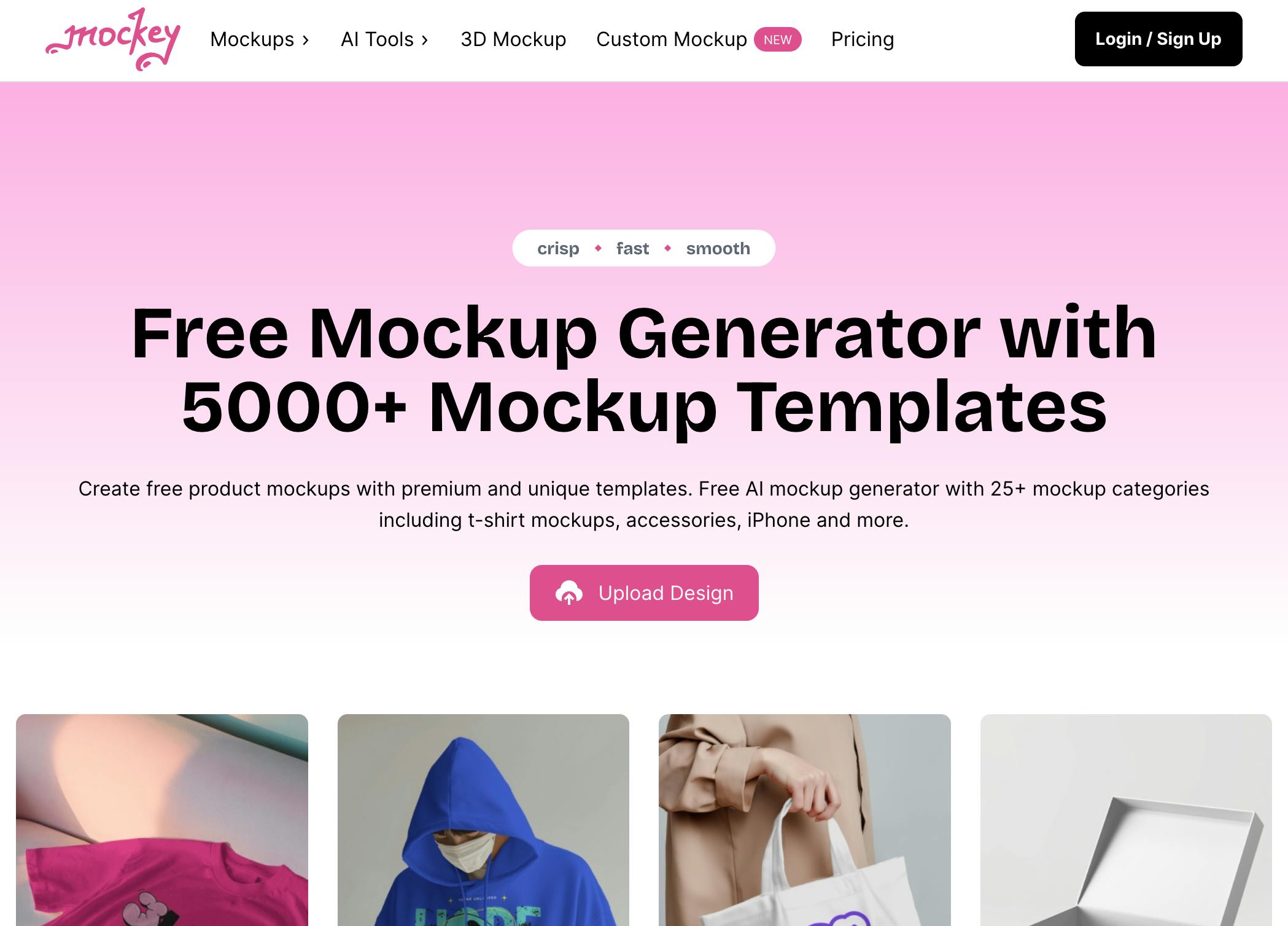Hitting $12k MRR just 11 months after turning a free side project into an AI
business

Pranay Agarwal left his job to focus on his AI side project, Mockey. At the time, it was only making money from ads, but he recently launched subscriptions. And 11 months later, it's bringing in $12k/mo.
Here's Pranay on how he did it. 👇
Build what you know
During my college years, I discovered my passion for UI/UX Design, which led me to forgo the traditional campus placement route in favor of establishing myself as a freelancer. This allowed me to work on various projects in design and UX.
Currently, my cofounder, Mofid Ansari, and I are working on Mockey.ai, an AI-powered online mockup generator that generates approximately $12k in monthly revenue. Additionally, I maintain a side project called Doodles, which is a free Figma community resource offering handcrafted illustrations for designers to incorporate into their work.
Getting started
In 2021, I was working for Blinkstore.in — a self-hosted print-on-demand platform for the Indian market founded by Mofid — when he and I identified a significant gap in the mockup generation space. Existing solutions were limited, slow, and typically required Photoshop knowledge, creating a barrier for many users.
Recognizing this opportunity, Mofid and I quickly developed an MVP that could generate mockups directly in the browser, which we integrated into Blinkstore. The immediate increase in usage validated our concept and encouraged further development.
Mofid and I continued building Mockey as a nights-and-weekends project. And by December 2023, recognizing Mockey's significant potential, I made the decision to leave my full-time position at a startup to focus exclusively on growing our product.

A basic MVP
We launched with a focused offering of t-shirt mockups only. The initial development phase took approximately two months to master the fundamental technical requirements — placing designs on shirts, modifying garment colors, and accurately wrapping designs to conform to natural fabric wrinkles and creases.
Initially, we utilized royalty-free images in our mockups, but our timing coincided perfectly with advancements in AI technology, allowing us to generate high-quality mockup images without traditional limitations. It was like ordering a pizza and having Gordon Ramsay show up at your door offering to cook a five-course meal instead. Was this pure dumb luck or our secret genius foresight? I'll just smile mysteriously and let you believe we had a crystal ball hidden in our startup garage.
We prioritized accessibility in our interface design, minimizing cognitive load for users. Our signature instant preview functionality was strategically implemented to allow users to visualize their designs across multiple mockups simultaneously.
Our technology stack consists of Vue.js for the frontend and Node.js powering our backend infrastructure.
We've remained completely bootstrapped since our inception in 2021, initially forgoing salaries to reinvest in Mockey's development.
Subscription + ads
We use a subscription + ads combo for our business model. Free users can grab up to three mockups per day, plus they'll see ads in various spots throughout the site.
Ads bring in about $700/mo ad we get about 100k visitors per month. We rolled out subscriptions in April 2024 and we're now pulling in about $12k monthly.
Back in the day, we used to just let everyone download as many mockups as they wanted. But once we added those download limits our revenue shot up 3x.
Turns out people are pretty motivated when they hit those "you've reached your limit" messages.
Growth via SEO and communities
Our initial marketing approach was opportunistic yet strategic. After building our MVP, we integrated it directly into Blinkstore.in, which already enjoyed strong keyword rankings. This implementation provided Mockey with immediate visibility and helped establish our early SEO foundation.
Recognizing the significant potential of organic search traffic, we invested heavily in SEO through targeted content creation, strategic link building, and mockup-focused material. However, we made a tactical error by publishing tool reviews and AI news articles that, while generating substantial short-term traffic, ultimately proved detrimental when Google algorithm updates began to penalize this content.
This experience taught us the importance of authenticity and niche focus—we promptly realigned our strategy to concentrate exclusively on mockup-related keywords, deliberately avoiding the temptation of high-volume but less relevant search terms.
Beyond search optimization, we leveraged design communities as powerful distribution channels for our mockups and content. One particularly successful initiative was creating a free Figma community file that enabled users to generate mockups directly within Figma, while strategically including calls to action directing them to our full application for expanded capabilities.
This reinforced a valuable lesson: Never underestimate the impact of community engagement. Even seemingly basic niches can experience exponential growth through effective word-of-mouth marketing when you provide genuine value to specialized communities.
Parting advice
Focus on solving a real problem
Don't build something just because it sounds cool. Build something that solves a genuine problem that you or others face. With Mockey, we identified a clear gap in the mockup generation market — existing solutions were limited, slow, and often required specialized software knowledge.
Start small and validate quickly
Begin with a minimal viable product that solves the core problem. We started with just t-shirt mockups and a basic interface. This allowed us to validate our idea quickly and get real user feedback before expanding.
Use nights and weekends effectively
You don't need to quit your job immediately. We built Mockey while working full-time during the COVID period. It takes discipline, but this approach minimizes financial risk while you validate your idea.
Focus on user experience
Make your product as intuitive and accessible as possible. We deliberately designed Mockey with minimal cognitive load, which helped with user adoption.
Don't forget the larger vision
When faced with daily challenges and setbacks, keeping the big picture in mind provides clarity and purpose, helping to ensure that even seemingly disconnected decisions ultimately contribute to our broader objectives.

Leave a Comment
this is super interesting .. I am currently building an AI business myself and the process is scaring me a lot because of imposter syndrome and reading too many reddit posts stating AI businesses are doomed to fail
I wouldn't read into that too much mate.
i can feel it, what's the product? what are you selling?
I’m working on something called Ophilia—a branding co-founder for idea-stage founders and creators who get stuck trying to shape their product into something coherent and pitchable.
More about story, clarity, and emotional resonance than logos or one-click outputs. Would love to hear what you’re building too :)
Ophilia sounds super interesting, love the focus on story.
That’s something a lot of early-stage founders struggle with.
And I’m currently building Pick and Partner, a platform that helps newsletter creators grow organically through cross-promotions.
We’re focused on helping small and mid-sized newsletters get meaningful exposure so they can stand strong in a competitive space and reach bigger audiences without relying solely on ads or algorithms.
Happy to discuss more on your idea if you're interested, always happy to have more people to discuss entrepreneurship in my network.
If you're up for a chat, feel free to reach out on X @sricharan10g 😊
I love the concept :) Pick and Partner sounds genuinely thoughtful and useful - there is always room for new, meaningful newsletters and they just get eaten up by big competition .
Would totally love to chat and exchange notes if you’re up for it. I’m usually more active on IndieHackers & email than X, but happy to reach out there too if that’s best.
This is great encouragement for me. Thanks for sharing it. I'm working on rolling out a project later this week. Im super nervous about it. I guess I just have to trust my research and the fact that I poured in a lot of data to scope my model. Here's hoping!
That's amazing! Thank you for all your advice, tips and also for sharing your experiences! It's really valuable for those of us who are at the beginning of the difficult journey of starting our own business. 👌
Incredible growth, especially with a freemium model and strong SEO focus. Love the balance of ads and subscriptions. Inspiring stuff for those of us still in the build-and-validate phase.
Great success story, companies and founders like them should also offer collabs and affiliates to multiply their reach and conversion. I checked the site, I am not able to find any info about it.
So informative, thanks for sharing James
This is amazing !
How do you can users/clients ?
It's very effective strategy, especially regarding SEO, we seem to be making the same mistake, and the strategy in the Figma community document is indeed very clever!!!
have you tried SEO before, would like to know your experience.